Meteor Season Starts, the Waxing Moon Leaves Venus and Joins Jupiter and Saturn, Venus Kisses Antares!

This Lunar Reconnaissance Orbiter image shows Sinus Iridum, the Bay of Rainbows, on the northwestern edge of large Mare Imbrium, the Sea of Clouds. The “Golden Handle” is the curved Jura Mountains, the remains of an impact crater that has been flooded by basalt magma flows. The feature, which is easy to see without a telescope, looks best when the terminator falls just to the west, a few days before full moon each month.
Happy Thanksgiving, Canadians!
Here are your Astronomy Skylights for the week of October 10th, 2021 by Chris Vaughan. Feel free to pass this along to your friends and send me your comments, questions, and suggested topics. You can also follow me on Twitter as @astrogeoguy! Unless otherwise noted, all times are expressed in Eastern Time. To subscribe to these emails please click this MailChimp link.
I can bring my Digital Starlab portable inflatable planetarium to your school or other daytime or evening event, or teach a session online. Contact me through AstroGeo.ca, and we’ll tour the Universe, or the Earth’s interior, together! My terrific new book with John A. Read entitled 110 Things to See With a Telescope is a guide to viewing the deep sky objects in the Messier List – for both beginners and seasoned astronomers. DM me to order a copy!
The waxing moon will shine prettily after sunset this week, perfect for exploring in a backyard telescope. The moon will leave Venus on Sunday and pass the gas giant planets at mid-week. Meanwhile, we get one more week of morning Zodiacal Light, and two overlapping meteor showers! Read on for your Skylights!
The Moon
This is the week of the lunar month when our planet’s partner is perfectly positioned for perusal! The moon will be shining in the evening sky all over the world. And the earlier sunsets will let even the youngest junior astronomers have a look before bedtime!
Tonight (Sunday) the moon will rise at lunch time and then cross the sky all afternoon. Once the sky begins to darken after sunset, the pretty, crescent moon will shine in the south-southwestern sky, 1.5 fist diameters to the upper left (or celestial east) of blazing-bright Venus. Before long the bright, reddish star Antares, the pulsing heart of Scorpius, will twinkle below and between the moon and Venus. Take a photo of them and tag me on social media!

The moon will steadily increase its angle from the sun this week. As it does so, it will set later each night, and grow in illuminated phase – a process known as waxing. The pole-to-pole boundary that divides the dark and lit hemispheres of the moon is called the terminator. For someone standing anywhere along that line on the moon, the sun would be peeking over the eastern horizon. Earth’s own terminator sweeps over you after sunrise every day because the Earth completes one rotation every 24 hours.
Since the moon is tidally locked, keeping the same hemisphere pointed toward Earth at all times, the moon completes one full rotation in the same amount of time it takes to orbit the Earth, or 27.3 days. The fact that Earth is moving around the sun at the same time delays the reoccurrence of the same lunar phase – so the lunar terminator will sweep past any point on the moon (or a future Lunar Outpost!) every 29.53 days. That extra half day is also the reason why the phases of the moon occur at different times each month.
The near-horizontal sunlight along the moon’s terminator casts deep black shadows to the west of every bump, ridge, crater rim, and mountain – producing breathtaking views of the waxing moon in a telescope. And the steady march of the terminator changes the show night after night and hour by hour! Dust off that old telescope!
On Monday night, the Canadian Thanksgiving Holiday, the crescent moon will shine just above the stars that form the spout of the Teapot-shaped asterism in Sagittarius (the Archer). On Tuesday at 11:25 pm EDT (or 03:25 Greenwich Mean Time on Wednesday, October 13), the moon will officially complete the First Quarter of its tour around Earth, and will sit just to the left of the teapot’s handle. The moon’s 90 degree angle away from the sun at that time produces an exactly half-illuminated moon – on its eastern side. The terminator will temporarily become a straight line, and then spend the rest of the week bending the other way as the moon becomes gibbous (i.e., more than half-illuminated). The varying shape of the terminator told ancient astronomers that the moon was a sphere orbiting the Earth.
The moon’s monthly visit with the bright gas giant planets Saturn and Jupiter will kick off after dusk on Wednesday. Before the sky has darkened, try using binoculars to find the yellowish dot of Saturn positioned a generous palm’s width to the upper left (or 7 degrees to the celestial northeast) of the half-illuminated moon. Or wait until Saturn is visible with your unaided eyes, sometime after 7 pm local time. Much brighter Jupiter will be shining off to their upper left all night.
After 24 hours of eastward motion the waxing gibbous moon will sit below and between Jupiter and Saturn all evening on Thursday night. The trio, with much brighter and whiter Jupiter to the left (celestial east) of fainter Saturn, will make a nice widefield photo when composed with some interesting foreground scenery. After sunset on Friday, the bright, waxing gibbous moon will land a large palm’s width to the lower left (or 8 degrees to the celestial southeast) of Jupiter, with Saturn visible off to their right. After Friday, the moon will bid adieu to the bright planets until they meet again on November 10-12.
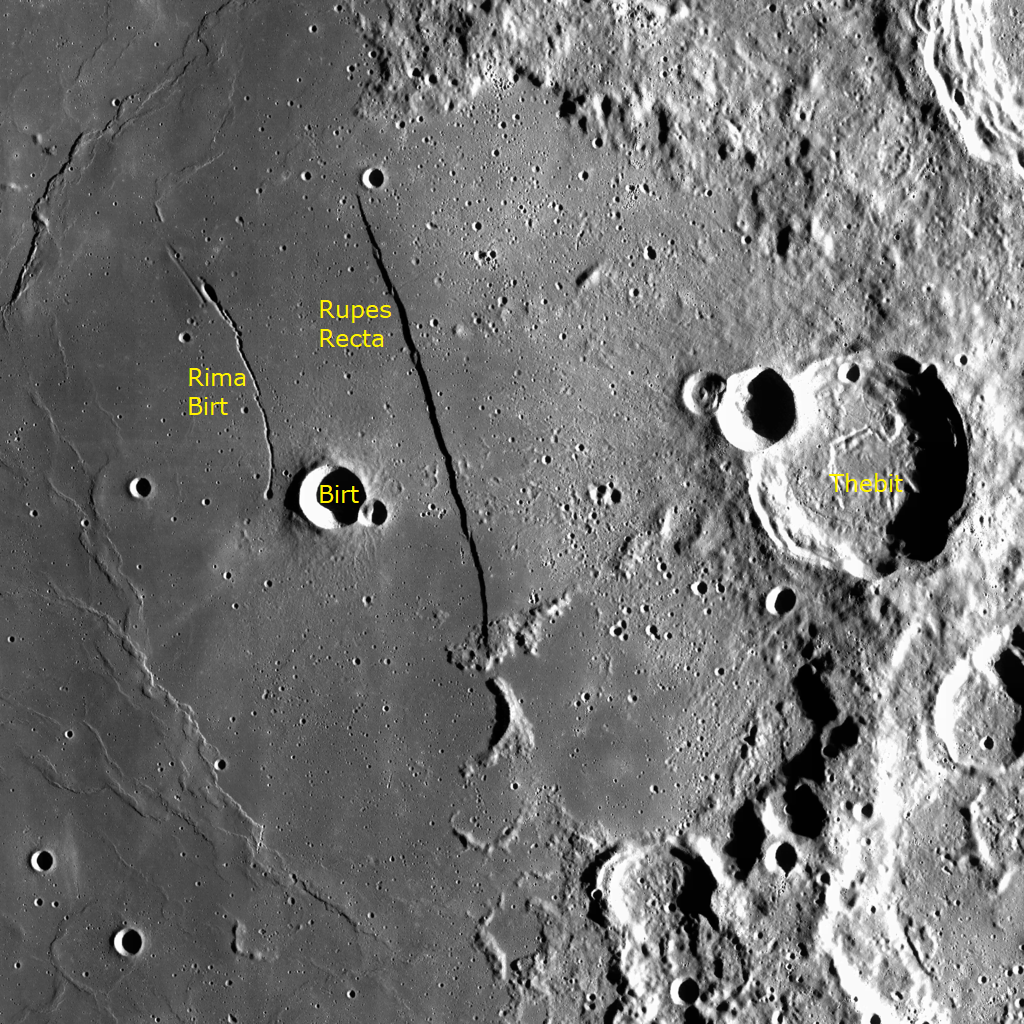
On Thursday and Friday night, the terminator will fall just to the left (or lunar west) of Rupes Recta, also known as the Lunar Straight Wall. The feature is very obvious in a backyard telescope. The rupes, Latin for “cliff”, is a north-south-aligned fault scarp that extends for 110 km across the southeastern part of Mare Nubium, the Sea of Clouds. That’s the large, dark region located in the lower third of the moon’s Earth-facing hemisphere. The Straight Wall is always prominent a day or two after first quarter, and shows well again just before third quarter. For reference, the Straight Wall is located above (to the lunar north) of the bright, prominent crater Tycho, which is famous for its lengthy and arrow-straight rays extending across much of the moon’s disk. That ray system is composed of material blasted out when Tycho was formed.
The moon’s trip past the gas giants occurred among the faint stars of Capricornus (the Sea-Goat). The nearly full moon will spend next weekend in next-door Aquarius (the Water-Bearer). On Sunday night, October 17, the terminator on the waxing gibbous moon will fall west of Sinus Iridum, the Bay of Rainbows. The circular, 249-km-diameter feature is a large impact crater that was partly flooded by the same basalts that filled the much larger Mare Imbrium to its right (lunar east). An effect called the “Golden Handle” is produced when slanted sunlight brightens the eastern (right-hand) side of the prominent, curved Jura Mountains – part of the old crater rim that surrounds the bay on the top and left (lunar north and west). The “mountains” extend into Mare Imbrium as a pair of protruding promontories named Heraclides and Laplace, at the bottom and top, respectively. You can see the curved feature with sharp eyes – and very easily in binoculars and backyard telescopes. Sinus Iridum is almost craterless, but hosts a set of northeast-oriented wrinkle ridges that are revealed under magnification at this phase.
Orionids Meteor Shower
We’ve finally entered meteor shower season! Over the next few months, Earth will experience a wave of several showers. The minor Draconids Meteor Shower, which runs between October 6 and 10 every year, will conclude tonight. This shower, generated by debris dropped by Comet 21P/Giacobini-Zinner, usually delivers relatively few meteors that will streak away from the northerly constellation of Draco (the Dragon) – but the shower has occasionally been much more prolific.
The excellent Orionids Meteor Shower, which is derived from fine particles dropped by repeated passages of Comet Halley, runs from September 23 to November 27, and is observable world-wide. The Orionids (for short) will ramp up this week, but the shower won’t reach peak intensity until Thursday, October 22. Unfortunately, a full moon will compete with the meteors on the peak night – so now is good time to keep an eye out for some.
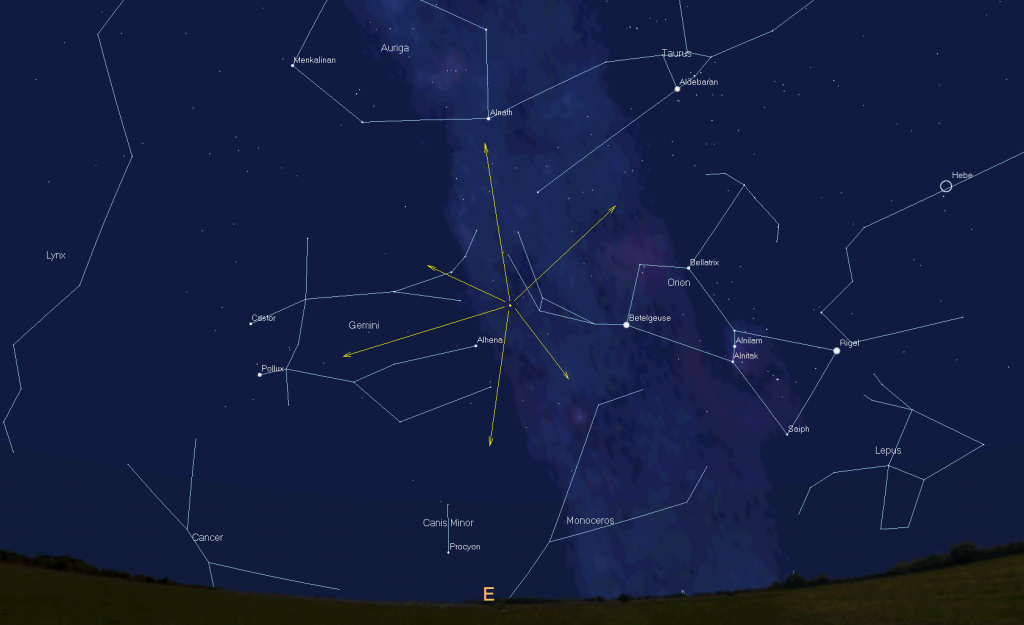
Although not too numerous, Orionids are known for being bright and fast-moving. You’ll see more Orionids in the hours between midnight and dawn (in your local time zone), when the shower’s radiant in Orion (the Hunter), which gives this shower its name, is highest in the sky. During this week, the waxing moon will set before the wee hours, leaving the pre-dawn sky darker for meteor-watchers.
You can watch for meteors before midnight, too. Keep looking up!
Morning Zodiacal Light for Mid-Northern Observers
During autumn at mid-northern latitudes every year, the ecliptic extends nearly vertically upward from the eastern horizon before dawn. That geometry favors the appearance of the faint zodiacal light in the eastern sky for about half an hour before dawn on moonless mornings. Zodiacal light is sunlight scattered by interplanetary particles that are concentrated in the plane of the solar system – the same type of material that produces meteor showers. It is more readily seen in areas free of urban light pollution. For observers at low latitudes, the ecliptic is nearly vertical all year round, making the light a frequent phenomenon. Sadly, observers above 60°N latitude miss out.
If your location favors it, between now until the full moon on October 20, look for a broad wedge of faint light extending upwards from the eastern horizon and centered on the ecliptic. It will be strongest in the lower third of the sky, below Leo’s brightest star Regulus. Try taking a long exposure photograph to capture it. Don’t confuse the zodiacal light with the Milky Way, which is positioned nearby in the southeastern sky.
The Planets
Venus will continue to catch your eye every evening – even after tonight’s visit by the crescent moon. This week, the extremely bright planet should emerge from the post-sunset twilight by 7 pm local time and then set around 8:30 pm. Venus will not be much higher than the trees and rooftops, so you might need to walk around until you find an open view to the west-southwest. Once the sky has darkened more, the bright, reddish star Antares will appear twinkling to Venus’ left. Venus will move closer to Antares every night this week. The pair will be binoculars-close from October 11 to 20, but at closest approach on Saturday, they’ll share the field of view in the eyepiece of a telescope at low magnification. If you have trouble seeing Antares beside 150 times brighter Venus, try hiding the planet just outside of your field of view.
When viewed in a backyard telescope Venus will exhibit a featureless, football-shape. That’s because it’s only 55%-illuminated right now due to its position well east of the sun. Venus will grow in size and wane in phase every week for the rest of this year. Aim your telescope at Venus as soon as you can spot the planet in the sky (but ensure that the sun has completely disappeared first). That way, Venus will be higher and shining through less distorting atmosphere – giving you a clearer view of it.
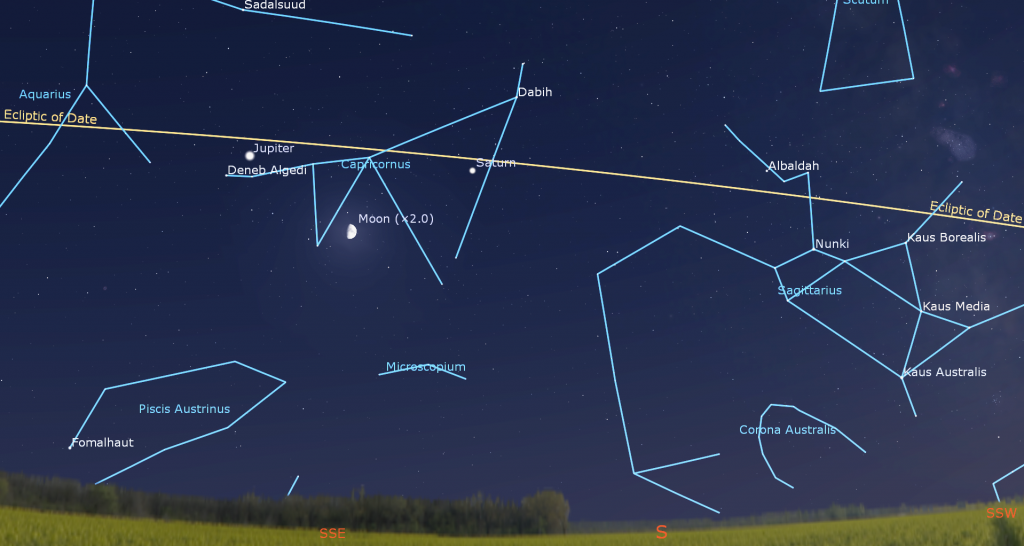
While Venus is dropping lower in the darkening west-southwestern sky, one-third as bright Jupiter will pop out of the twilight over in the southeast. A short time after 7 pm local time, the fainter, yellowish dot of Saturn will show up less than two fist diameters to Jupiter’s right (or 16° to the celestial west). The two gas giants will cross the night sky together amidst the faint stars of Capricornus (the Sea-Goat) and then set in the southwest after 1 am local time. Sadly, the low position of the ecliptic on September evenings is keeping those planets in the lower third of the sky, where their light must punch through two to three times as much of Earth’s distorting atmosphere – reducing their crispness in telescopes. Starting next year, the eastward orbital motion of the two planets will shift their best viewing months from summer into autumn, when they’ll be able to shine higher in the sky.
Binoculars and small telescopes will show you the Jupiter’s four large Galilean moons named Io, Europa, Callisto, and Ganymede. Since Jupiter’s axial tilt is a miniscule 3°, those moons always look like beads strung on a line that passes through the planet, and parallel to Jupiter’s dark equatorial belts. That line of moons and the belts tilt as Jupiter crosses the sky. The moons’ arrangement varies from night to night because Io orbits Jupiter once every 42 hours. The other moons take between 3.5 and 16.7 days.
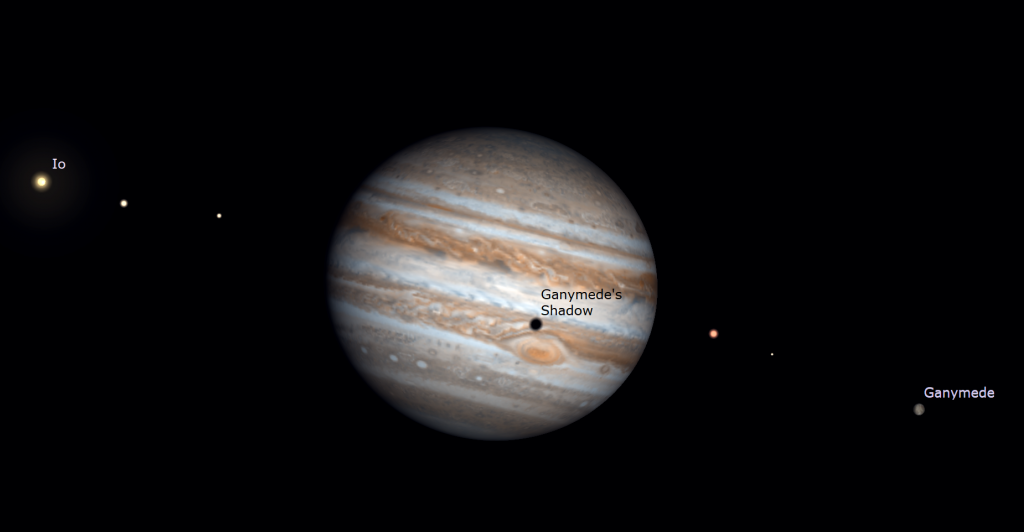
For observers in the Eastern Time Zone with good telescopes, the Great Red Spot (or GRS) will be visible while it crosses Jupiter after dusk on Monday (with Ganymede’s shadow!), Wednesday, and Saturday, and in late evening on Friday. It can also be observed after midnight tonight, Friday, and next Sunday night.
From time to time, the small, round, black shadows cast by Jupiter’s Galilean moons become visible in amateur telescopes when they cross (or transit) the planet’s disk. Ganymede’s large shadow will cross Jupiter’s disk, with the Great Red Spot, between 7 pm and 10:20 pm EDT on Monday night, October 11! Europa’s small shadow will cross from 9:20 pm to 12 am EDT on Thursday night.
On Monday, Earth’s faster orbit will cause Saturn to appear to stop moving with respect to the distant stars. The temporary pause in motion marks the end of a westward retrograde loop that began on May 23. For the rest of this year the planet will return to its usual easterly prograde motion.
Saturn’s thrilling rings are visible in any size of telescope. If your optics are sharp and the air is steady, try to see the Cassini Division, a narrow gap between the outer and inner rings. Look for a faint, dark belt encircling the planet, too. Remember to take long, lingering looks through the eyepiece – so that you can catch moments of perfect atmospheric clarity.
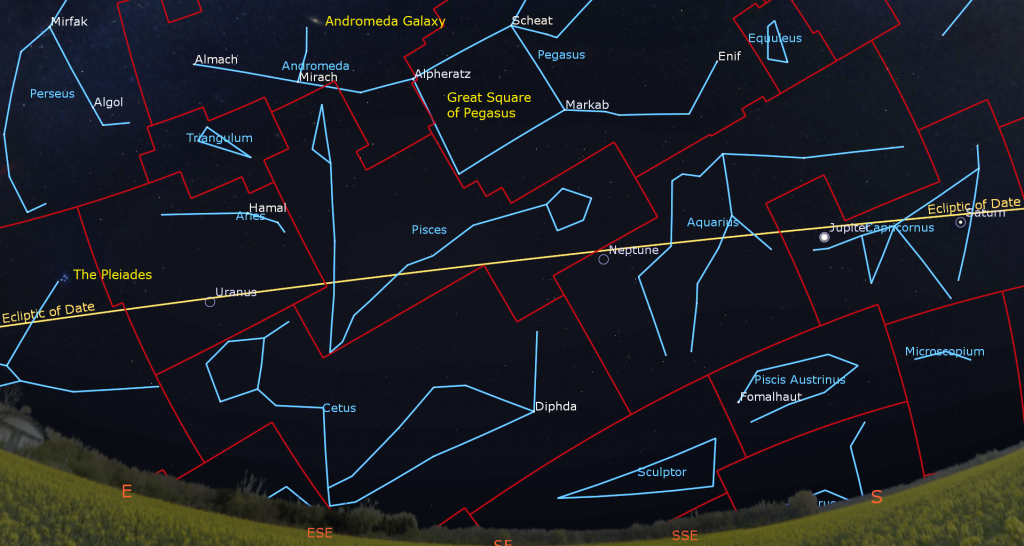
From here on Earth, Saturn’s axial tilt of 26.7° lets us see the top of its ring plane, and allows its brighter moons to array themselves all around the planet. Saturn’s largest and brightest moon Titan never wanders more than five times the width of Saturn’s rings from the planet. The much fainter moon named Iapetus can stray up to twelve times the ring width. Iapetus is dark on one hemisphere and bright on the other, so it looks dimmer when it is east of Saturn, and it looks brighter when it is west of Saturn. Iapetus will reach minimum its brightness of magnitude 11.46 on October 29 and then double in brightness to magnitude 11.59 on December 8. The next brightest moons Rhea, Dione, Tethys, Enceladus, and Mimas all stay within one ring-width of Saturn.
During this week, Titan will migrate counter-clockwise around Saturn, moving from the lower left (celestial east) of Saturn tonight to the right (celestial west) of Saturn next Sunday. Iapetus will be positioned above (celestial north) of Saturn tonight (Sunday, October 10), and then shift increasingly to the left (east) of Saturn during the balance of this week. (Remember that your telescope will probably flip the view around.) How many of the moons can you see in your telescope?
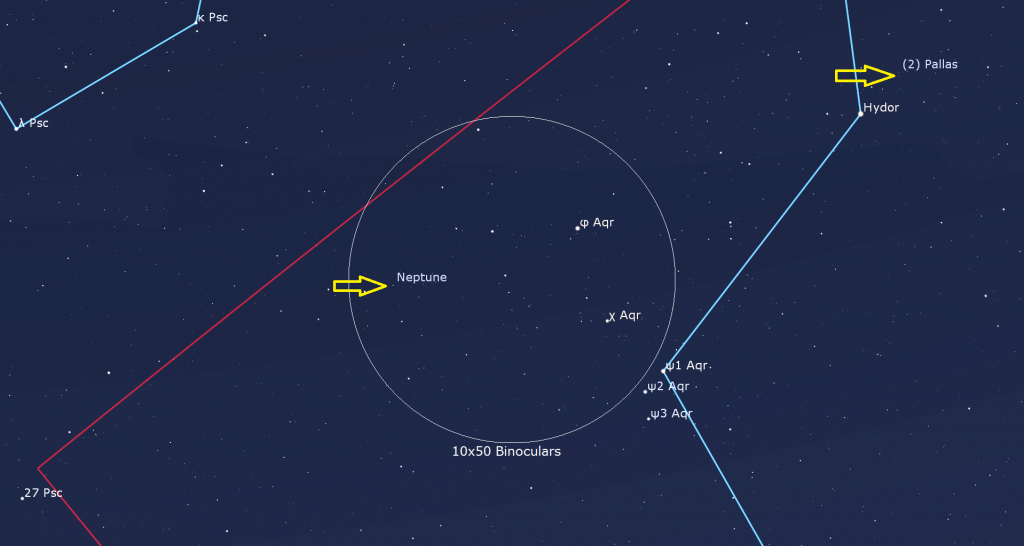
Distant, blue Neptune is in the sky all night long, near the border between Aquarius (the Water-Bearer) and western Pisces (the Fishes) – and roughly three fist diameters to the left (or celestial east) of Jupiter. To help you find the magnitude 7.8 planet, use binoculars to locate the up-down grouping of five medium-bright stars Psi, Chi, and Phi Aquarii (or ψ, X, and φ Aqr). (Psi Aquarii is a triple star!) The little blue dot of Neptune will sit several finger widths to the left (or 3.6 degrees to the celestial NNE) of the top star, Phi. The main belt asteroid named (2) Pallas is nearby. This week, it will be traveling downward (or southward) through Aquarius, about a finger’s width to the right (celestial west of) the bright star Hydor.
Once again this week Magnitude 5.7 Uranus will be observable from late evening onward – especially after midnight, when it will have climbed more than halfway up the southeastern sky. Slow-moving Uranus is spending all of this year parked below Hamal and Sheratan, the two brightest stars in Aries (the Ram). It’s also positioned about 1.6 fist diameters to the upper right (or 16 degrees to the celestial west-southwest) of the Pleiades star cluster. This week the blue-green planet will pass closely above the equally bright star Omicron Arietis – but Uranus will show more colour and less twinkling than that star.
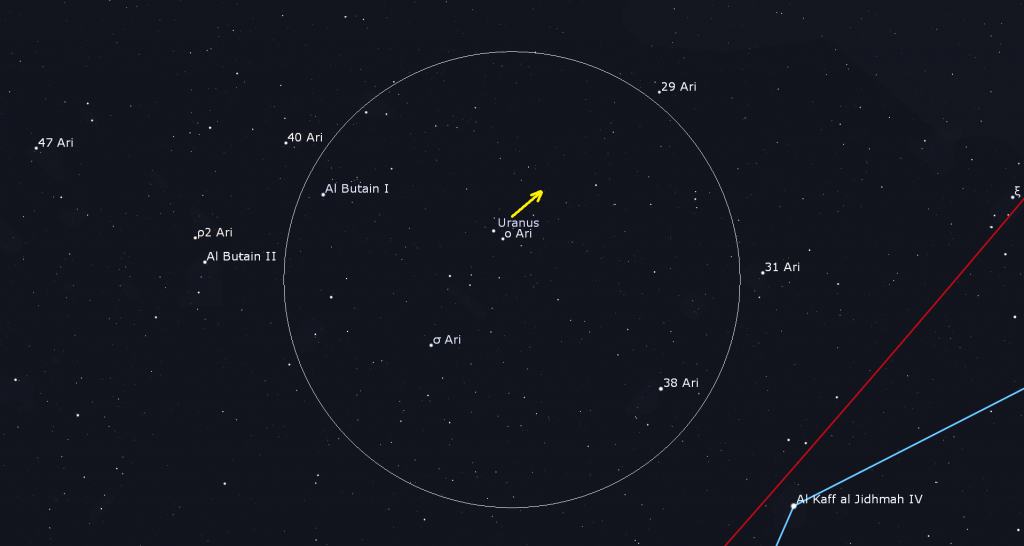
Both Mercury and Mars passed solar conjunction yesterday. Mercury will re-appear low in the eastern pre-dawn sky at the end of this week. Mars will join it in early November.
Pegasus Flies on High
If you missed last week’s piece on the constellation Pegasus (the Winged Horse), I posted it with pictures here. The star tour will still work while the moon waxes.
Public Astro-Themed Events
Every Monday evening, York University’s Allan I. Carswell Observatory runs an online star party – broadcasting views from four telescopes/cameras, answering viewer questions, and taking requests! Details are here. Their in-person Wednesday night viewing has been converted to online via the observatory YouTube channel.
My free, family-friendly Insider’s Guide to the Galaxy webcasts with Jenna Hinds of RASC National returns on Tuesday, October 12 when we’ll cover multi-wavelength astronomy and the James Webb Space Telescope. You can find more details and the schedule of future sessions here.
On Saturday night, October 16, my friends at Indus Space will celebrate International Observe the Moon Night with a live, free broadcast featuring views of the moon through astronomers’ telescopes and special guests. More information and the Eventbrite link are here.
Don’t forget to take advantage of the astronomy-themed YouTube videos posted by RASC Toronto Centre and RASC Canada.
Space Station Flyovers
The ISS (or International Space Station) won’t be visible over the GTA this week.
Keep looking up, and enjoy the sky when you do. I love questions and requests. Send me some!